Understanding Drop Boards in Skateboarding Culture
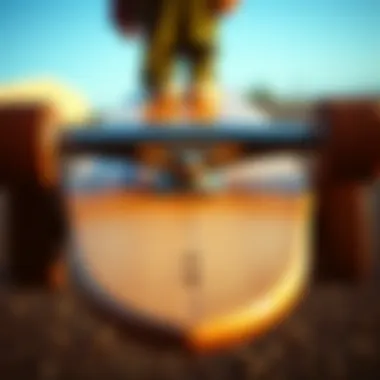
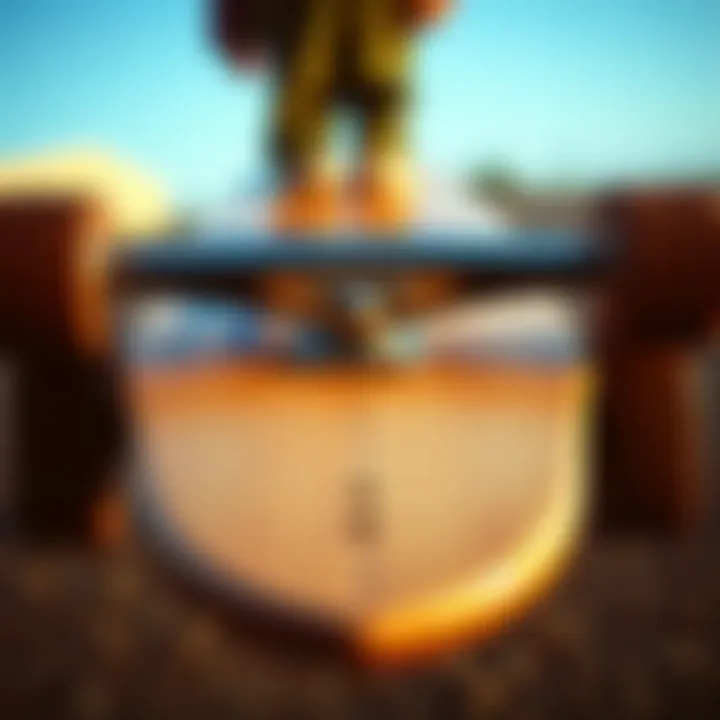
Intro
Skateboarding is more than just a mode of transportation; it's a culture, a way of life, and for many, a form of expression. Among the diverse styles and boards that have gained traction, drop boards hold a special significance. These boards, which differ markedly in design from traditional setups, have carved out their niche within the skate community. Understanding the nuances of drop boards—how they emerged, what makes them unique, and their practical benefits—can profoundly reshape both a novice's experience and a seasoned rider's performance.
This exploration begins by unpacking the fundamentals of drop boards, delving into their design intricacies, and observing how they contrast with other types of skateboards. Riding a drop board isn’t just about cruising but about understanding the subtleties that come with different types of boards, as well as grasping the implications on user experience.
Drop boards are a favorite for those seeking stability and control, an essential mix that can elevate one’s skating game.
We'll also investigate the demographics that tend to favor these boards, the pros and cons associated with them, and even provide insights into selecting the right one based on individual needs. As the landscape of skateboarding continuously evolves, this guide aims to reflect on current trends while contemplating future developments in drop board usage. Whether you’re a skateboarder navigating your first ride or a parent seeking the best for your child, this comprehensive examination has something for everyone.
Prolusion to Drop Boards
Drop boards have carved out a niche of their own in the diverse world of skateboarding. They hold a significant place for those who are either getting started and want more stability, or seasoned riders drawn to their unique features. Drop boards set themselves apart with design and functionality that cater to a wide range of riding styles, making them an essential topic of discussion.
Definition and Origin
Drop boards are known for their lowered deck compared to traditional skateboards. This design places the rider's feet closer to the ground, contributing to a significant increase in stability during rides. Originally developed as a response to the needs of downhill skaters, drop boards allow for better weight distribution and thus sharpen turning capabilities. The origin of these boards can be traced back to a time when riders sought greater control while tackling steep hills and performing tricks that traditional skateboards struggled with. As skateboarding evolved, so too did the demand for specialized boards that could handle different techniques and terrains.
The Evolution of Skateboarding Boards
The history of skateboarding boards can be likened to a tapestry, woven with threads of innovation, design, and user demand. Skateboards started as simple planks of wood, but over the decades, the shift towards performance-driven boards saw the introduction of various shapes and sizes. The early evolution emphasized board length and width, but in time, both the drop board and other specialized boards emerged from a need for versatility in use.
The introduction of advanced materials and flattened profiles further highlighted the evolution. Boards designed for racing and tricks adopted unique enhancements that would enhance performance based on rider's specific needs. For instance, the use of lighter materials enabled riders to perform intricate tricks, and stability was enhanced through design adaptations, such as drop-through setups.
Understanding these transitions provides insight into not just how drop boards came about but also how they serve to meet the varying demands of skateboarders today. Whether one skates for leisure or sport, recognizing the historical context of one's equipment can give new depth to the experience.
"The world of skateboarding is ever-changing; each type of board tells the story of innovation and personal preference."
In summary, the importance of drop boards in skateboarding cannot be overstated. They symbolize the search for improved technique, control, and the overall riding experience. Mastering a drop board opens a door to not just new tricks, but an entire culture that celebrates individuality and self-expression.
Understanding Drop Board Design
When it comes to skateboarding, the design of the board plays an integral role in how riders experience their pastime. Understanding the nuances of drop board design is essential for both enthusiasts and those new to the sport. Drop boards are not just another variation; they come packed with unique features that enhance rider experience through tailored functionality. These boards are crafted to deliver stability, control, and ease of maneuverability, appealing to a wide spectrum of skateboarders from beginners to veterans.
The design elements of drop boards can directly impact performance, making it imperative for every rider to grasp their characteristics. From materials used in construction to the variations in shape and size, each aspect influences how well the board can handle different skating styles and environments. As we delve deeper into this subject, it becomes clear that understanding these design principles can greatly assist riders in selecting the right board for their individual needs, ensuring both safety and enjoyment.
Materials Used in Construction
The materials that build a drop board tell a story not only about its durability but also about the riding experience it offers. Typically, these boards feature a core made from high-quality maple wood, known for its resilience and flexibility. Maple is often layered in various thicknesses, allowing for a strong yet lightweight structure. Some boards integrate materials like bamboo for added flexibility or plastic composites for specific designs aimed at urban skating.
Popular materials in drop board constructions include:
- 9-ply maple: Commonly used due to its stiffness and ability to provide a firm grip underfoot.
- Bamboo: Appreciated for its lightweight nature and flexibility, allowing for a smooth ride.
- Fiberglass: Sometimes incorporated in the top layers for added strength and flexibility, making the board more responsive to rider inputs.
- Plastic composites: Utilized in certain models aimed at casual users or for specific flex purposes.
Choosing the right materials directly correlates to the intended use of the board. For example, if riders plan on primarily cruising or commuting, lighter materials could be favored. However, if high-speed descents or tricks on ramps are the goal, heavier, sturdier materials may be the way to go.
Shape and Size Variations
The shape and size of drop boards are one of the defining features setting them apart from other board types. Generally, drop boards have a lower center of gravity, providing increased stability and making them easier to balance. They often come with wider decks, allowing for better foot placement and control during tricky maneuvers.
When discussing shape and size, several factors come into play:
- Deck Width: Larger widths offer more stability but can hinder speed due to the increase in surface area. Boards typically range from 8.5 to 10.5 inches, optimal for different foot sizes and riding styles.
- Length: Standard drop boards vary from 36 to 42 inches in length. Longer boards can provide more stability and comfort for cruising, while shorter ones are often quicker to maneuver.
- Concave Shape: This feature can vary significantly. A deep concave allows for better foot grip during tricks, while a flatter shape offers more room for movement.
Examples of varying designs include:
- Flat-drop: Helps in downhill riding by keeping the center of gravity low.
- W-concave: Offers two different heights which assist in tight turns and sharper control.
- Kicktail: Providing options for performing tricks while still benefiting from drop stability.
Understanding these variations plays a pivotal role in matching a rider's style to their equipment. Recognizing personal preferences in riding shapes and sizes can make a world of difference, ensuring a smoother, more enjoyable skating experience.
For those interested in deeper insights on materials and design variations, the Wikipedia page on skateboard design can be a valuable resource.
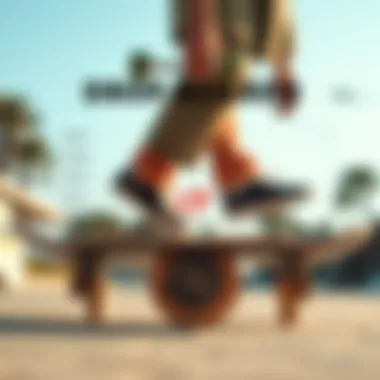

In summary, the construction materials and design characteristics of drop boards are foundational to their performance. Riders are encouraged to assess what suits their style, preferences, and riding goals to secure the optimal board.
Benefits of Choosing Drop Boards
When it comes to selecting a skateboard, the decision often hinges on personal preferences and riding styles, but drop boards stand out for several compelling reasons. Understanding their benefits can greatly enhance the experience, especially for skateboarders looking to maximize stability and maneuverability. Let’s dig deep into what truly makes drop boards an appealing choice for enthusiasts.
Stability and Control
One of the significant advantages of drop boards is their excellent stability. This stems primarily from their lower center of gravity, which keeps riders grounded. When you’re cruising down a hill or executing a trick, that feeling of being securely planted on your board is not just comforting—it’s crucial. Riders often find that the design of drop boards minimizes wobbling during high-speed runs, making them advantageous for downhill riding.
"For many skateboarders, stability is the bedrock of confidence. Without it, every curve feels like a gamble."
To appreciate this stability, consider how the shape of a drop board contrasts with other board types. The drop deck design often incorporates a concave structure that hugs the rider’s feet. This enhances grip, allowing for better control during maneuvers. As a rider pivots, the stability offered helps maintain balance, leaving you free to focus on the ride instead of worrying about potential spills.
Here are some core aspects that contribute further to stability:
- Lower Deck Height: By lowering the platform, drop boards enable riders to feel the pavement beneath them, reducing the likelihood of losing control.
- Wide Wheelbase: A broader wheelbase naturally offers more stability, making it suitable for tricks involving wide stances.
- Quality Bearings: Well-manufactured bearings can play a pivotal role in ensuring that the ride is smooth, aiding in maintaining overall control because less energy is lost to friction.
Enhanced Maneuverability
In addition to stability, drop boards also offer enhanced maneuverability. The design often accommodates sharper turns and quicker responses. Riders frequently appreciate how these boards handle various terrains—from smooth sidewalks to rough skate parks.
The ability to maneuver with agility is particularly useful for skaters who enjoy street tricks or navigating crowded areas. Since the center of mass is closer to the deck, making tight turns feels more intuitive and natural. This responsiveness can make all the difference when trying to avoid obstacles or switch directions quickly.
Several features contribute to this improved adaptability:
- Wheel Size Options: Many drop boards come equipped with larger wheels, designed for tackling uneven surfaces, which enhances the ride quality significantly.
- Truck Features: With adjustable trucks, riders can modify their setups to favor tighter turning circles when needed, depending on the scenario.
- Foot Placement Design: The way these boards are shaped allows skaters to shift their foot positions easily, giving fluidity to transitions and tricks.
Comparative Analysis with Other Board Types
Understanding the differences between drop boards and other types of skateboards is pivotal for anyone entrenched in skate culture or simply looking to pick a board that suits their needs. Each type brings unique characteristics to the table, influencing the choice based on individual riding style, preferences, and even terrain challenges. Comparing drop boards to regular skateboards and longboards reveals a multifaceted landscape of design philosophy and functionality, which reflects how different boards cater to varying forms of expression within the sport.
Drop Boards vs. Regular Skateboards
When juxtaposing drop boards against regular skateboards, several key differences emerge.
Firstly, the drop board's design significantly impacts stability and control. Regular skateboards typically have a higher deck, which can make them more challenging for beginners or riders focusing on tricks. Conversely, drop boards sit lower to the ground, providing a more solid stance that can enhance balance and enable easier push-offs, benefiting a rider's stability.
In terms of maneuverability, regular skateboards offer a more agile riding experience due to their lighter weight and higher center of gravity. They excel in performing tricks and flips, which is less pronounced with drop boards. However, for someone who values cruising and downhill rides, drop boards take the cake, allowing for smooth gliding over varied terrains.
Considerations on flexibility vary as well. Regular skateboards often come with more rigid decks designed to support heavy ollies and jumps. Drop boards, on the other hand, might incorporate some flex, providing a more cushioned experience over bumps and cracks in the pavement, a feature that many find appealing especially during long rides.
- Stability: Drop boards have a lower center of gravity.
- Maneuverability: Regular skateboards are lighter and better for tricks.
- Flexibility: Drop boards can absorb shocks better due to the design.
Drop Boards vs. Longboards
In examining the relationship between drop boards and longboards, the discussion pivots around intended use and performance attributes. Longboards generally favor recreational cruising, with a longer wheelbase providing stability during high-speed rides.
Drop boards, while also designed for stability, are engineered to enhance downhill riding more than longboards. The drop design of a board allows for a deeper center of gravity, thus improving control during sharp turns and downhill sections. Riders who prioritize high-speed descents may find that drop boards add an extra layer of confidence when racing down hills, compared to the sometimes wobblier longboard counterpart.
In terms of length and maneuverability, longboards are far bulkier and can be difficult to maneuver in tight spaces. Drop boards, depending on their variation, often maintain a manageable length while still giving riders the thrill of speed and ease. Ultimately, drop boards stand out by combining elements of ease-of-use and high performance, making them appealing for both casual cruisers and those looking to tackle steep declines.
In summation, assessing the differences between drop boards, regular skateboards, and longboards not only helps prospective buyers understand what suits their needs best but also potently reflects broader trends in the skate community. As with all elements of this vibrant culture, individual preference ultimately reigns supreme.
"Choosing the right board is like picking a partner in skateboarding – it’s all about compatibility with your riding style."
User Demographics and Preferences
Understanding the user demographics and preferences surrounding drop boards is essential in crafting an effective and targeted approach to skateboarding. It is not just about the ability of the board but also about who is riding it and what they seek from their experience. By delving into the demographics of skateboarders, brands can align their products with the desires and needs of riders better. A well-rounded grasp of the audience, from their skill levels to their typical riding styles, forms the backbone of any meaningful discussion about drop boards.
Target Audience for Drop Boards
The target audience for drop boards usually skews slightly younger, typically appealing to teenagers and young adults drawn in by the thrilling aspects of the sport. However, this demographic isn't limited solely to age but also includes various lifestyle choices and even fashion trends.


People who prefer drop boards often look for stability and a heightened sense of control at higher speeds—these boards give them that need for speed while enabling tricks too. Apart from the thrill-seekers, parents often find drop boards attractive for their children; the boards are generally easier to manage and provide a more stable platform for beginners.
Additionally, there’s a burgeoning community of mature riders who gravitate towards drop boards for recreational cruising and commutes, given their durability and unique appeal. This variation in usage often reflects on branding and marketing strategies. Engaging with niche communities through social media platforms like Reddit or specialized skateboarding forums can unveil hidden trends and preferences, giving companies a nuanced view of their audience.
Rider Skill Levels and Board Preferences
Rider skill levels significantly influence board preferences, especially in the context of drop boards, which cater to a wide range of abilities. Beginners often opt for drop boards due to their forgiving design—making falls less punishing while facilitating confidence to try new maneuvers. Riders at this level value stability over everything and find comfort in the lower center of gravity drop boards provide.
Meanwhile, intermediate riders explore the nuances of control and precision that these boards offer. At this stage, they tend to experiment with different shapes and sizes to find what feels best for their riding style.
For advanced skateboarders, drop boards can be an exciting tool for tricks, providing an unexpected avenue for creativity with their unique design. It’s common to see seasoned riders modifying their boards and adding personal flair, honing in on their distinctive style.
Ultimately, matching a rider’s skill level with the right drop board can make all the difference in enjoyment and performance.
The right board caters not just to the skills of the rider but also their aspirations.
In summary, understanding the demographics and preferences of drop board users can guide brands and retailers in decision-making processes regarding specific features, designs, and marketing strategies. By focusing on these key elements, the industry can create a more enriched skateboarding experience for riders at all levels.
Practical Considerations When Choosing a Drop Board
When it comes to selecting a drop board, understanding practical considerations is paramount. Choosing the right board can significantly enhance the riding experience, whether you’re gliding down smooth streets or tackling rougher terrains. This section will delve into the key elements that every skateboarder should mull over before making a purchase. It isn't just about picking a board that looks cool; it's about making a choice that aligns with your individual riding style, preferences, and needs.
Assessing Riding Style
Every skateboarder has a unique riding style, which is often shaped by their environment and personal preferences. Before committing to a drop board, it's crucial to identify how you plan to use it. Are you interested in downhill skating, cruising through the neighborhood, or executing tricks at the skatepark?
- Downhill Riding: If high speeds and stability are your priorities, a drop board’s lower center of gravity can be a game-changer. This design helps in maintaining balance while allowing for sharp turns.
- Freestyle and Tricks: For those focused on doing tricks, a more versatile board with a responsive design might be essential. Drop boards generally offer more stability but might limit some trick capabilities compared to standard skateboard shapes.
- Cruising: A drop board can provide a smooth ride thanks to its design, making it an excellent choice for those seeking leisurely rides. The trucks and wheels often allow for a comfortable experience over various terrains.
It's helpful to know which of these categories resonates with your skating. Some riders might also find they transition between styles, so picking a versatile drop board can help cater to a broader range of activities.
Board Duration and Durability
Beyond immediate preferences, considering the longevity of the board you choose is vital. Skateboards undergo significant wear and tear, and being aware of your drop board's durability can save you both money and hassle in the long run. Here are some factors to ponder:
- Material Quality: The construction materials significantly impact the board's lifespan. High-quality woods like maple can withstand more stress than cheaper alternatives.
- Wear and Tear Management: Regular use of the board shifts attention to its components, such as wheels and trucks, which will require replacements over time. Noting how easily these parts can be replaced will assist in maintaining the overall durability of your setup.
- Riding Frequency: If you skate daily, consider a board specifically designed for heavy use. On the contrary, if you plan occasional skating trips, a more budget-friendly option might suffice.
- Environmental Impact: Boards made from sustainable materials not only tend to last longer but also align with eco-conscious values many riders share today.
"Selecting the right drop board is an investment in your skating journey. Choose wisely for the best ride!
For more insights and community discussions about drop boards, you might find resources like Reddit and Wikipedia helpful.
Top Brands and Product Recommendations
When it comes to selecting the right drop board, the brand can mean the difference between a lackluster experience and one that truly transforms how a rider interacts with the pavement. Well-established brands typically carry a reputation for quality and reliability, while emerging brands often shake things up with innovative designs and fresh perspectives. This section will delve deeper into both emerging and established brands, offering insights that can guide skateboarders, parents, and retailers alike in making informed choices.
Emerging Brands Worth Considering
In recent years, several new players have entered the drop board scene, pushing the envelope with unique designs and materials. Consider checking out some of these up-and-coming brands:
- Riptide Boards: Known for experimenting with sustainable materials, Riptide offers a fresh take on eco-friendly skateboarding. Their boards enhance the riding experience without compromising the planet.
- Zenith Skateboards: Zenith is gaining traction among freestyle riders. With their focus on creating lightweight boards that still provide plenty of sturdiness, they appeal to those who crave tricks and flips.
- Gnarboard: This brand is steadily rising among urban riders who need mobility and performance. With slick designs and customizable features, Gnarboard attracts a younger audience looking for something more than just a standard drop board.
Emerging brands can often provide value not just through pricing but by introducing innovative features that might not yet be common in more well-entrenched brands. Keep an eye on customer reviews, as they can offer insight into a product's real-world performance and durability.
Established Brands with Proven Track Records
Established brands have years of experience and a track record to prove it. They often provide boards that audiences trust, bolstered by solid warranties and customer support. Some top choices include:
- Element Skateboards: Renowned for their commitment to quality and sustainability, Element boards are made from strong materials that balance performance with durability. They're often favored by riders in both street and park setups.
- Santa Cruz Skateboards: This brand has been a staple in the skateboarding community for decades. The iconic designs and reliable performance of their boards resonate well with both amateur and pro skaters alike.
- Enjoi Skateboards: Known for producing fun yet high-quality boards, Enjoi has a loyal following. Their quirky graphics, combined with robust construction, make them ideal for riders who value personality as much as performance.
"Quality and reputation matter; it’s like buying a ticket to the best show in town, you want to ensure it’s worth your time and investment."
Whether a beginner or an experienced skater, understanding both the emerging and established brands equips riders with the knowledge to pick the drop board that aligns with their personal style and needs. Always check reviews on platforms like Reddit for the latest opinions and trends. This community-driven feedback can help clarify a brand's standing in the ever-evolving world of skateboarding.
The Maintenance of Drop Boards
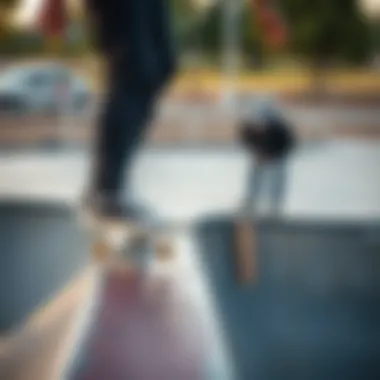
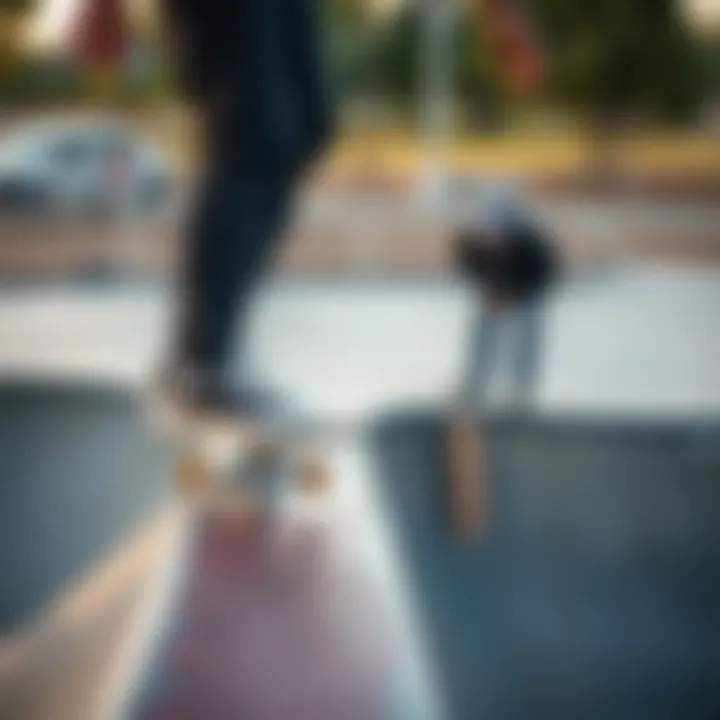
Maintaining drop boards properly isn’t just about keeping them looking fresh; it’s crucial for performance and longevity. A well-maintained skateboard not only rides better but can also prevent injuries. Proper care can make the difference between a board that lasts for years and one that breaks after just a few months. Riders who understand how to care for their boards will also enjoy their sessions more, as a well-functioning board can enhance the overall experience.
Routine Care Techniques
Regular maintenance is key to ensuring your drop board performs at its best. Here are a few techniques you can easily fit into your routine:
- Inspect Your Board: Take a minute before each ride to look over your board. Check for cracks, chips, or any signs of damage that might not be visible before.
- Clean Your Board: Grit and grime can affect your grip tape and the overall feel. Use a damp cloth to wipe down the deck. For a deeper clean, a soft brush can help remove dirt.
- Check the Wheels and Bearings: Examine the wheels for flat spots and ensure they spin freely. If they feel sluggish, consider cleaning or lubricating the bearings. A little bit of bearing oil goes a long way.
- Tighten Hardware: If there's any rattling during your ride, it might be due to loose screws or bolts. Regularly tighten everything, especially after a hard session. This can prevent more damage and improve safety.
"A skateboard is like a relationship; it needs care, attention, and occasionally some repairs to thrive."
Common Problems and Solutions
Even with diligent maintenance, problems can still arise. Here are some common issues and how to tackle them:
- Worn Grip Tape: If your grip tape starts losing its texture, it can hinder your performance. Replacing it is straightforward; you can order pre-cut grip tape or buy a sheet and cut it to size. To apply it, peel off the backing and align it carefully on the deck, smoothing out any air bubbles.
- Cracked Deck: A cracked deck is serious. Depending on the extent of the crack, you might be able to reinforce it with epoxy, but often it’s best to replace the board altogether. Riding a cracked board can lead to accidents.
- Loose Trucks: If your truck feels wobbly, this could affect your turning and balance. Invest in a proper skate tool to make adjustments easily and ensure that both front and back trucks are evenly tightened.
- Flat Spots on Wheels: If you notice your wheels aren’t rolling smoothly anymore, flat spots may be the culprit. While you can rotate your wheels to even out wear, if the flat spots are significant, it’s best to replace the wheels to maintain performance.
Taking care of a drop board doesn’t have to be a daunting task. With some routine checks and a few handy techniques, any skateboarder can keep their board in top-notch shape, enhancing both safety and performance on the streets.
The Role of Drop Boards in Skate Culture
Drop boards hold a significant position in the broader landscape of skateboarding culture. They serve as a bridge connecting the sport's rich history with contemporary trends, all while catering to a diverse group of skateboard enthusiasts. Understanding the role of these boards extends beyond mere preference; it speaks to the evolution of skating techniques, community engagement, and the personal expression that is intrinsic to skateboarding.
The advent of drop boards introduced new possibilities for riders, allowing them to pursue various skating styles while maintaining essential balance and control. The design itself facilitates gravity-friendly maneuvers, making it easier for skateboarders��—from beginners to seasoned pros—to embrace tricks that may have been challenging on traditional boards. In a culture increasingly focused on creativity and the development of unique styles, drop boards empower riders to experiment. This adaptability opens the door for fresh ideas, pushing the boundaries of what can be achieved on a skateboard.
"Drop boards not only enhance performance but also enrich the culture by fostering creativity and pushing limits."
Influences from Skateboarding Icons
The impact of skateboarding icons cannot be overstated. Influential riders like Tony Hawk and Nyjah Huston often shape prevailing trends and preferences, helping popularize certain styles and, indirectly, specific board types. These athletes inspire countless fans to emulate their tricks and styles, integrating drop boards into their riding practices. The narrative isn’t just about the performers; it’s about how these icons elevate the status of drop boards within the skateboarding community.
Many skateboarders look up to these figures for guidance and inspiration. When a prominent skater showcases their skills on a drop board during competitions or in videos, it inevitably leads to increased interest and demand among aspiring skateboarders. The palpable influence of these athletes can be seen as more than just promotion; it transforms the public perception of drop boards, presenting them as viable and desirable options within the sport.
Ultimately, the synergy between skateboarding icons and drop boards elevates the boards in practical applications and as cultural symbols.
Community Perspectives and Trends
Community consensus plays a vital role in establishing the desirability and relevance of drop boards. Discussions on online forums, social media pages, and local skate parks create a buzz that transcends generations. Skateboarders often share personal experiences, reviews, and preferences, contributing to the collective wisdom about various board styles.
Social media platforms like Instagram and YouTube have revolutionized how skateboarders interact. Riders frequently post videos showcasing their drop board tricks, which not only ignites excitement but helps create trends. Observing peers execute impressive tricks or navigate challenging terrains encourages others to explore similar avenues.
It's also worth noting that local skate shops serve as hubs for community engagement around drop boards. Events like demos, workshops, and meet-ups cultivate a shared understanding of the boards' capabilities and encourage dialogue about their pros and cons among enthusiasts of all skill levels.
Key Observations from the Community:
- Trends evolve quickly: What’s popular today may fade tomorrow, but drop boards maintain a secure foothold due to their adaptable nature.
- Inclusivity matters: Many boards cater to varying skill levels, making it easier for new skateboarders to join the fold.
- Sustainable practices: As awareness of environmental issues grows, there is a rising interest in eco-friendly materials used in the production of drop boards.
Future Trends in Drop Board Evolution
The world of skateboarding is not static, change is always at its heels. As skateboarding culture shifts, so do the tools that riders use, especially drop boards. Understanding future trends in drop board evolution is crucial for skateboarders, retailers, and parents alike, as it tells us where the sport is headed and what innovations might soon be riding the streets.
Innovative Designs on the Horizon
Fresh designs are popping up regularly, keeping the skateboard community on their toes. Here are some key areas where innovation is driving the evolution of drop boards:
- Hybrid Constructs: New boards are emerging that blend elements from various styles—think drop boards intertwined with aspects of longboards or street decks. This fusion caters to a wider range of skating styles, offering versatility that riders crave.
- Customizability: More boards are designed for personal customization. Riders can tweak the width, length, and even the concave to suit their skating preferences. This not only enhances the riding experience but also fosters a deeper connection between the skater and their board.
- Technology Integration: Boards have started incorporating tech features, like embedded sensors that track performance metrics such as speed and jump height. This data helps riders to improve their skills and refine their techniques.
"As the hybridization of designs continues, riders might find their perfect board mix without being tied to a single category."
- Ergonomics and Comfort: Boards that prioritize rider comfort are the talk of the town. With adjustable trucks and cushioning materials, the riding experience is becoming less about fatigue and more about performance.
The future is very much about personalization and performance enhancement, acknowledging that every skater has unique preferences.
Sustainability and Environmental Considerations
As the conversation about sustainability grows, so does the appeal for environmentally-friendly skating gear. The drop board industry is catching up with this important trend, creating options that are kind to the planet:
- Recycled Materials: A number of brands are now experimenting with recycled plastics and sustainably sourced woods in their drop board production. This commitment not only reduces waste but also appeals to eco-conscious riders.
- Biodegradable Boards: Innovators are creating boards that do not linger in landfills for years after being discarded. They’re made from biodegradable materials that break down, thus minimizing environmental impact.
- Carbon Footprint Transparency: Companies are starting to openly share information about their manufacturing processes, enabling consumers to make informed choices. This transparency helps build a community of responsible consumers who prioritize products that align with their values.
As the global community works together on environmental issues, drop board manufacturers are recognizing their role in sustainability. The future might hold a range of products that not only perform well but also contribute positively to the world around them.















